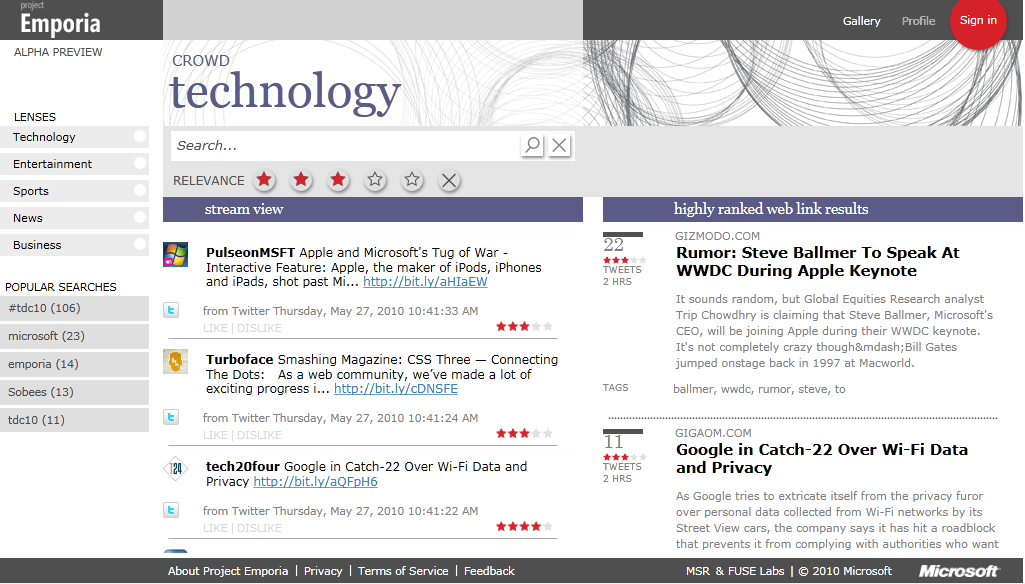Microsoft's social-networking lab launches new Twitter viewing tool

Microsoft's Future Social Experiences Labs (FUSE) has launched another new project, codenamed "Project Emporia," that is aimed at social-networking newbies to help them simplify their Twitter browsing/viewing experience.
The project, announced on May 27 at the Thinking Digital Conference in Gateshead, UK, is in alpha at this point. But it is open to anyone interested in trying it. Initially, only FUSE employees are able to access the like/dislike feature of the service, but that number will grow over time, according to the Softies.
(Click on image to enlarge.)
Project Emporia uses a recommender system trained on like/dislike feedback and provides users with a "lens" on their areas of interest. The service doesn't require users to have a Twitter account. It also will allow the aggregation of Tweets pointing to a particular Web page.
Microsoft is describing the project, which has been in development since March 2010, as a way to "enable a personalized search experience over publically available social network data."
A couple of interesting notes about Emporia that I found on the "about" page for the project:
Q: How is Project Emporia different from other Twitter/Facebook aggregators available (TweetDeck, etc)? What’s unique about it? A: There are many differences of Project Emporia to other Twitter/Facebook aggregators. To highlight a few:
1. Project Emporia allows users without a Twitter account to browse and find information on topics of interest to them. 2. While many Twitter & Facebook aggregators build entirely on top of the existing content distribution mechanism via the social network of a user, Emporia offers a new and innovative way of content distribution through the preference of the content itself. 3. Emporia enables a crowd-sourced web search scenario through using tweets which point to web links as relevance votes for the web links thereby enabling its users to get on top of thousands of tweets at once.
Q: Why FUSE Labs and not the Bing team? A: By way of background, you should recognize that FUSE Labs is explicitly chartered to explore “future social experiences,” and FUSE Labs is explicitly structured to do these kinds of incubation activities. For both these reasons, FUSE Labs has an extraordinarily high degree of experience with various social networking platforms including Facebook and Twitter. Given the team’s experience, Ray Ozzie felt it was appropriate for FUSE Labs to do this exploration and speculative development activity, integrating with Bing. As the work of Microsoft Research and our various Labs is proven out, product groups across the org factor both technologies and lessons learned into their plans for future releases.
Q: What was Microsoft Research’s role in this project? A: Based on long-term research in probabilistic modelling and inference, Microsoft Research created the Matchbox recommendation system which is the computational intelligence algorithm underlying Project Emporia. The Matchbox system predicts the value of an item for a user. It analyses past user behaviour based on the method of collaborative filtering combined with meta data describing users and items. Matchbox can be trained from different types of user feedback such as ratings or clicks in order to learn making good recommendations based on user-item preferences. In the case of Project Emporia, the system monitors user activity to recommend, in real time, relevant tweets to individual users and to groups sharing a common interest.
As with other FUSE Labs projects, like Spindex and Office Docs.com, Project Emporia is classified as "experimental" and there is no firm commitment or timetable for commercializing it.
